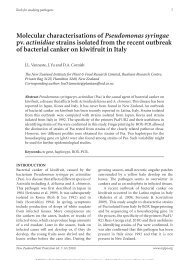field assessment of herbicides to release native plants from weeds
field assessment of herbicides to release native plants from weeds
field assessment of herbicides to release native plants from weeds
Create successful ePaper yourself
Turn your PDF publications into a flip-book with our unique Google optimized e-Paper software.
Weeds <strong>of</strong> the Natural Environment 373<br />
aminopyralid, as was the koromiko initially, while the clopyralid caused some damage<br />
<strong>to</strong> ribbonwood <strong>plants</strong> in the first few weeks after application (data not shown).<br />
Many <strong>of</strong> the broad-leaved species, especially the white clover, were removed by adding<br />
simazine <strong>to</strong> haloxyfop, and this treatment was <strong>to</strong>lerated well by all <strong>native</strong> species <strong>to</strong><br />
which it was applied. However, dandelion was poorly controlled, and grasses eventually<br />
reinvaded when the lower rate <strong>of</strong> simazine was used. Double the rate <strong>of</strong> simazine was<br />
used only for the purei, which <strong>to</strong>lerated this higher rate well, and grasses were prevented<br />
<strong>from</strong> re-establishing with this higher rate over the 15 weeks <strong>of</strong> moni<strong>to</strong>ring. This higher<br />
rate <strong>of</strong> simazine combined with haloxyfop would be an interesting treatment <strong>to</strong> test on<br />
other <strong>native</strong> species. The addition <strong>of</strong> simazine <strong>to</strong> shielded applications <strong>of</strong> glyphosate<br />
would also be worth investigating, as this would help keep glyphosate-cleared ground<br />
free <strong>of</strong> <strong>weeds</strong> and would only cost $1.30 per 100 <strong>plants</strong> treated, comparing well with<br />
other treatments listed in Table 4.<br />
Terbuthylazine used by itself gave good knockdown <strong>of</strong> most weed species at the rate<br />
used in this trial (Table 4), and gave long-term control around the <strong>native</strong> <strong>plants</strong>. The<br />
addition <strong>of</strong> haloxyfop improved initial knockdown <strong>of</strong> grasses. However, the terbuthylazine<br />
generally had some detrimental effects on most <strong>native</strong> species <strong>to</strong> which it was applied,<br />
apart <strong>from</strong> the ribbonwood (Table 3).<br />
Dichlobenil can be used <strong>to</strong> control <strong>weeds</strong> in a wide range <strong>of</strong> woody ornamental and<br />
fruit species (Young 2009). It was tested on just the ribbonwood, where it gave reasonable<br />
levels <strong>of</strong> weed control over a prolonged period <strong>of</strong> time without damaging the ribbonwood<br />
(Tables 3 and 4). However, at costs exceeding $15 per 100 <strong>plants</strong> treated, it is much<br />
more expensive than all other treatments assessed (Table 4) and would thus probably<br />
not be considered viable.<br />
Some treatments combined metsulfuron and amitrole <strong>to</strong> see if they would give useful<br />
control <strong>of</strong> grass <strong>weeds</strong> around the grass species <strong>to</strong>e<strong>to</strong>e. However, there was no useful<br />
differential in susceptibility <strong>to</strong> these <strong>herbicides</strong> between the <strong>to</strong>e<strong>to</strong>e and the wide range<br />
<strong>of</strong> grass weed species present. The combination <strong>of</strong> damage <strong>from</strong> the <strong>herbicides</strong> and<br />
competition <strong>from</strong> poorly controlled grass <strong>weeds</strong> affected the <strong>to</strong>e<strong>to</strong>e as much or more<br />
than unshielded applications <strong>of</strong> glyphosate or haloxyfop around the <strong>plants</strong>.<br />
Results <strong>from</strong> this trial depended very much on how well grasses were controlled, and<br />
most treatments were designed <strong>to</strong> control grasses. Although some revegetation sites<br />
may have problems mainly with broad-leaved species, generally grasses are likely <strong>to</strong><br />
dominate revegetation projects due either <strong>to</strong> sites formerly being pastures or being in<br />
roadsides and other waste areas where perennial grasses have become dominant as part<br />
<strong>of</strong> ecological succession (Porteous 1993). Thus results <strong>from</strong> this trial should be relevant<br />
<strong>to</strong> a wide range <strong>of</strong> revegetation projects.<br />
ACKNOWLEDGEMENTS<br />
We would like <strong>to</strong> thank Robert Coulson <strong>of</strong> Rural Supply Technologies Ltd for funding<br />
the research and providing the <strong>native</strong> <strong>plants</strong>. Assistance <strong>from</strong> the <strong>field</strong> technicians for the<br />
Massey University Pasture and Crops Research Unit is also gratefully acknowledged.<br />
REFERENCES<br />
Chas<strong>to</strong>n T 2008. Financial budget manual 2008. Lincoln University, Lincoln,<br />
New Zealand. 675 p.<br />
Davenhill NA, Ray JW, Vanner AL 1997. Forest weed control manual. New Zealand<br />
Forest Research Institute, Ro<strong>to</strong>rua, New Zealand. 136 p.<br />
Harring<strong>to</strong>n KC, Schmitz HK 2007. Initial screening <strong>of</strong> <strong>herbicides</strong> <strong>to</strong>lerated by <strong>native</strong><br />
<strong>plants</strong>. New Zealand Plant Protection 60: 133-136.<br />
Porteous T 1993. Native forest res<strong>to</strong>ration: a practical guide for landowners. Queen<br />
Elizabeth II National Trust, Welling<strong>to</strong>n, New Zealand. 184 p.<br />
Smale MC, Whaley PT, Smale PN 2001. Ecological res<strong>to</strong>ration <strong>of</strong> <strong>native</strong> forest at<br />
Aratiatia, New Zealand. Res<strong>to</strong>ration Ecology 9: 28-37.<br />
Young S 2009. New Zealand Novachem agrichemical manual. Agrimedia Ltd,<br />
Christchurch, New Zealand. 779 p.<br />
© 2009 New Zealand Plant Protection Society (Inc.) www.nzpps.org Refer <strong>to</strong> http://www.nzpps.org/terms_<strong>of</strong>_use.html




